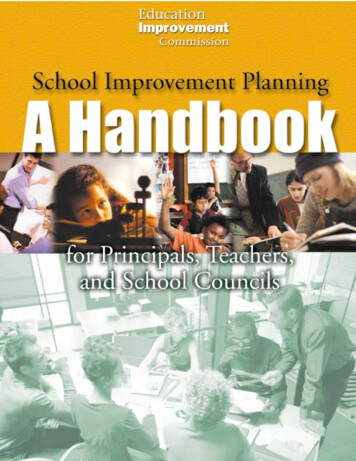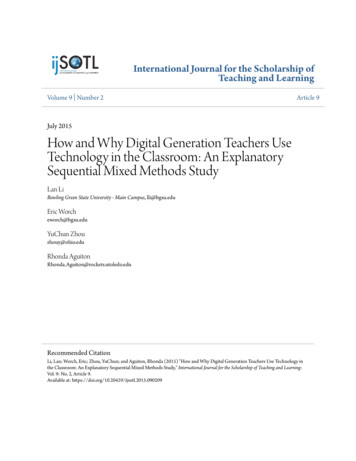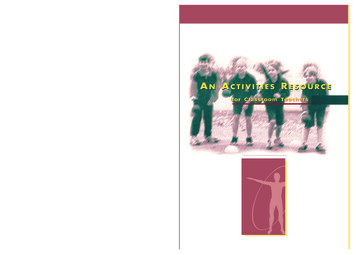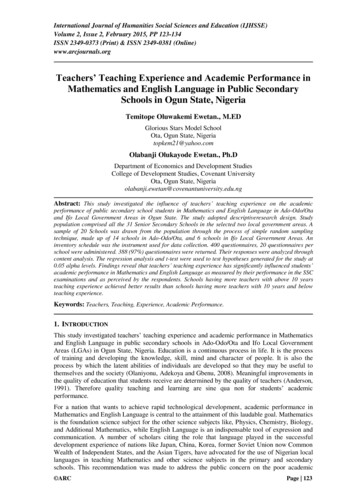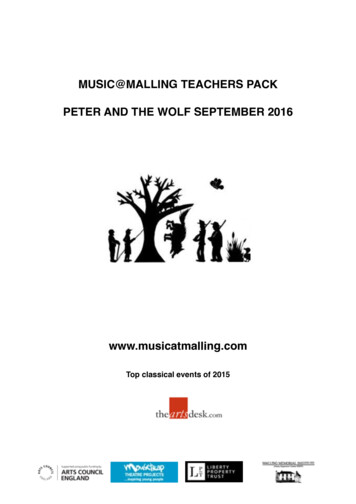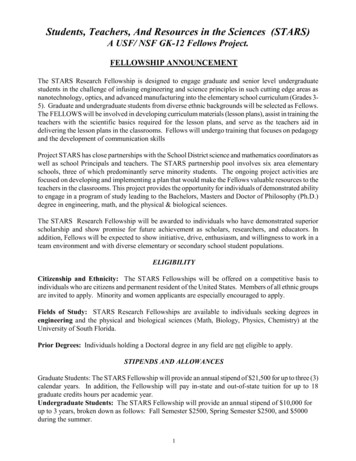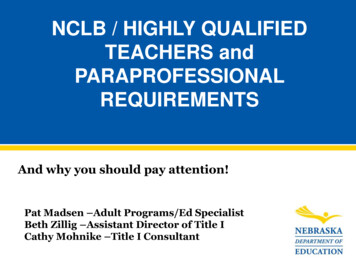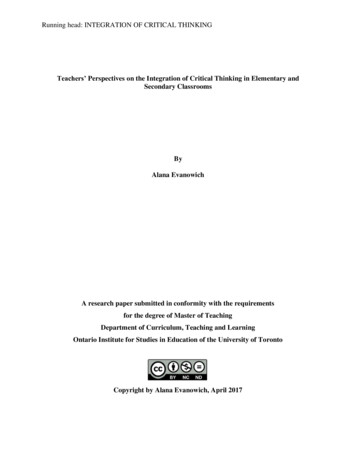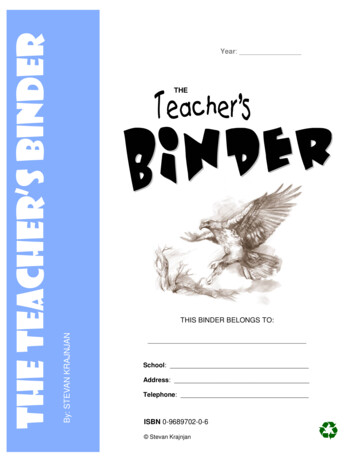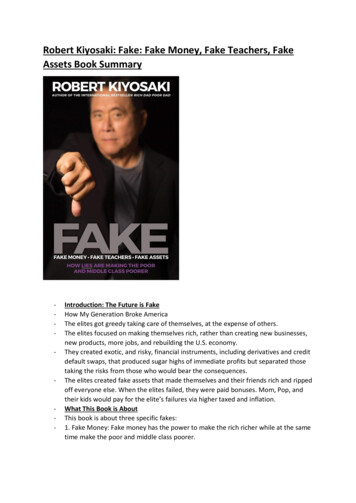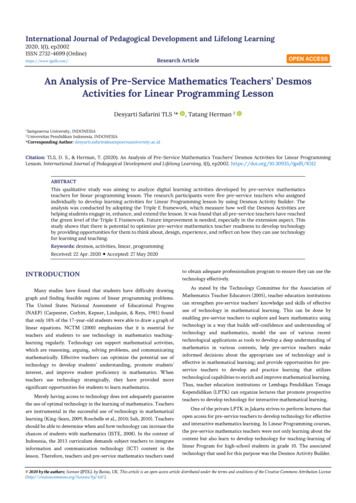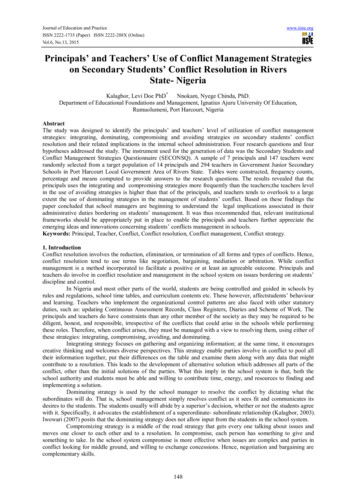
Transcription
Journal of Education and PracticeISSN 2222-1735 (Paper) ISSN 2222-288X (Online)Vol.6, No.13, 2015www.iiste.orgPrincipals’ and Teachers’ Use of Conflict Management Strategieson Secondary Students’ Conflict Resolution in RiversState- NigeriaKalagbor, Levi Doe PhD*Nnokam, Nyege Chinda, PhD.Department of Educational Foundations and Management, Ignatius Ajuru University Of Education,Rumuolumeni, Port Harcourt, NigeriaAbstractThe study was designed to identify the principals’ and teachers’ level of utilization of conflict managementstrategies: integrating, dominating, compromising and avoiding strategies on secondary students’ conflictresolution and their related implications in the internal school administration. Four research questions and fourhypotheses addressed the study. The instrument used for the generation of data was the Secondary Students andConflict Management Strategies Questionnaire (SECONSQ). A sample of 7 principals and 147 teachers wererandomly selected from a target population of 14 principals and 294 teachers in Government Junior SecondarySchools in Port Harcourt Local Government Area of Rivers State. Tables were constructed, frequency counts,percentage and means computed to provide answers to the research questions. The results revealed that theprincipals uses the integrating and compromising strategies more frequently than the teachers;the teachers levelin the use of avoiding strategies is higher than that of the principals, and teachers tends to overlook to a largeextent the use of dominating strategies in the management of students’ conflict. Based on these findings thepaper concluded that school managers are beginning to understand the legal implications associated in theiradministrative duties bordering on students’ management. It was thus recommended that, relevant institutionalframeworks should be appropriately put in place to enable the principals and teachers further appreciate theemerging ideas and innovations concerning students’ conflicts management in schools.Keywords: Principal, Teacher, Conflict, Conflict resolution, Conflict management, Conflict strategy.1. IntroductionConflict resolution involves the reduction, elimination, or termination of all forms and types of conflicts. Hence,conflict resolution tend to use terms like negotiation, bargaining, mediation or arbitration. While conflictmanagement is a method incorporated to facilitate a positive or at least an agreeable outcome. Principals andteachers do involve in conflict resolution and management in the school system on issues bordering on students’discipline and control.In Nigeria and most other parts of the world, students are being controlled and guided in schools byrules and regulations, school time tables, and curriculum contents etc. These however, affectstudents’ behaviourand learning. Teachers who implement the organizational control patterns are also faced with other statutoryduties, such as: updating Continuous Assessment Records, Class Registers, Diaries and Scheme of Work. Theprincipals and teachers do have constraints than any other member of the society as they may be required to bediligent, honest, and responsible, irrespective of the conflicts that could arise in the schools while performingthese roles. Therefore, when conflict arises, they must be managed with a view to resolving them, using either ofthese strategies: integrating, compromising, avoiding, and dominating.Integrating strategy focuses on gathering and organizing information; at the same time, it encouragescreative thinking and welcomes diverse perspectives. This strategy enable parties involve in conflict to pool alltheir information together, put their differences on the table and examine them along with any data that mightcontribute to a resolution. This leads to the development of alternative solution which addresses all parts of theconflict, other than the initial solutions of the parties. What this imply in the school system is that, both theschool authority and students must be able and willing to contribute time, energy, and resources to finding andimplementing a solution.Dominating strategy is used by the school manager to resolve the conflict by dictating what thesubordinates will do. That is, school management simply resolves conflict as it sees fit and communicates itsdesires to the students. The students usually will abide by a superior’s decision, whether or not the students agreewith it. Specifically, it advocates the establishment of a superordinate- subordinate relationship (Kalagbor, 2003).Iwowari (2007) posits that the dominating strategy does not allow input from the students in the school system.Compromizing strategy is a middle of the road strategy that gets every one talking about issues andmoves one closer to each other and to a resolution. In compromise, each person has something to give andsomething to take. In the school system compromise is more effective when issues are complex and parties inconflict looking for middle ground, and willing to exchange concessions. Hence, negotiation and bargaining arecomplementary skills.148
Journal of Education and PracticeISSN 2222-1735 (Paper) ISSN 2222-288X (Online)Vol.6, No.13, 2015www.iiste.orgConflict avoidance occurs when one party in a potential conflict ignores the conflicting issues ordenies the significant of the conflict to his life. It is a way of not addressing the conflict, or a tactical way ofpostponing the conflict for a better time, if at all such time will come. Note that in this situation, the principal orteacher is unassertive, and uncooperative. There is no intention to pursue one’s own needs or the needs of theschool. It connotes, the process of withdrawing from conflict situations in the school that might causeunpleasantness for the principal or teacher.From the forgoings, it should be stated that the school as a social system has its own norms and valuesand it is characterized by complex relationships between members of the system: principals, teachers, nonteaching staff and students. Due to the high degree of interdependence of duties and individual differences inrole expectations, conflicts do arise from different circumstances and situations among members of the schoolsystem and would be addressed by the application of the above mentioned strategies.In a related perspective, the major orientation of the school therefore, has been on supporting thesociety to socialize the students to be worthwhile as future leaders. As it is in any other institution, schools arecharacterized by social conflicts emanating from interactions among group members and formal structure ofauthority. The school involve dimensional conflicts both in the structural and behavioural patterns of theindividuals in the system.The above backdrops suggest that, it is imperative for principals and teachers to develop the relevantskills and styles to manage students’ conflicts with a view to achieving the aims and objectives of theeducational curriculum in secondary schools, specifically in Rivers State- Nigeria2. Statement of the ProblemIn Nigeria today, there exist basically a national system of education. Despite this, schools are diverse in theirorganizational structure with attendant emerging conflicts arising therefrom. To enhance goal achievement,school officials (Principal and teachers) operate on formal organizational structures which enable them in theperformance of their institutional daily activities.In spite of these operational guidelines, school officials are observed to engage on diversifiedapproaches on general school administration which invariably breeds conflicts. Nevertheless, the impact of thesediversities in the management of these schools leads to certain conflicts arising within the administration as aresult of nomothetic dimension which stresses institutional roles, rules, regulations and procedures for gettingthings done to achieve institutional goals; and the ideographicdimension, which stresses social interaction ofindividual’s need. Therefore, conflicts create serious administrative problems particularly in the school system,and need to be addressed, with a view to resolving them as they arises.The study therefore examined principals’ and teachers’ conflict management strategies in thesecondary schools. In otherwords, the study tend to identify the extent different conflict management strategiesare used by principals and teachers in students’ conflict resolution, and their related implications in internalschool administration. in Rivers State- Nigeria.Purpose of the StudyThe study sought to determine:1.Principals and teachers level of utilization of integrating strategy in the management of students’conflicts in schools.2.Principals and teachers level of utilization of dominating strategy in the management of students’conflicts in schools.3.Principals and teachers level of utilization of the compromising strategy in the management of students’conflicts in schools.4.Principals and teachers level of utilization of the avoiding strategy in the management of students’conflicts in schools.Research QuestionsThe following research questions addressed the problem and objectives of this study.1.What is the level of opinions of principals and teachers about their use of the integrating strategy in themanagement of students’ conflicts in the Government Junior Secondary Schools?2.What is the level of opinions of principals and teachers about their use of the dominating strategy in themanagement of students’ conflicts in the Government Junior Secondary Schools?3.What is the level of opinions of principal and teachers about their use of the compromising strategy inthe management of students’ conflicts in the Government Junior Secondary Schools?4.What is the level of opinions of principal and teachers about their use of the avoiding strategy in themanagement of students’ conflicts in the Government Junior Secondary Schools?149
Journal of Education and PracticeISSN 2222-1735 (Paper) ISSN 2222-288X (Online)Vol.6, No.13, 2015www.iiste.org3. MethodologyThe study was basically a descriptive survey design. The population comprised all the fourteen (14) principals,and five hundred and eighty – eight (588) teachers in the fourteen (14 ) Universal Basic Secondary Schools inPort Harcourt Local Government Area of Rivers State. The sample size which consisted of 7 principals and 147teachers was selected through the simple random technique.A 16 items structured questionnaire was used to collect data. The data collected were analysed usingthe frequency counts, percentage, and mean rating. The instrument was validated by two professors inEducational Management. The internal consistency and the reliability of instrument were tested using Pearson –Product Moment Correlation Co-efficient which yielded a score of 0.85.The modified four- point Likert response scale was used in providing answers to the questionnaireitems. KEY: strongly agree 4points; agree: 3points; disagree: 2points; strongly disagree: 1point.PRESENTATION, ANALYSIS AND DISCUSSION OF FINDINGSThe analyses of data and discussion of findings from the Secondary Students’ and Conflict ManagementStrategies Questionnaire (SECONSQ), which provided answers to the research questions, were presented thus:Research Question 1:What is the level of opinions of principals and teachers about their use of the integrating strategy in themanagement of students’ conflicts in schools?Table 1S/N1.2.3.4.ITEMStudents’ conflict issues are investigatedbefore any conflict is resolved.Students involved in a conflict are alwaysallowed to find solutions to the resolution ofthe conflict in the school.The consensus decisions in the resolution ofstudents conflicts are often re-enforced.Creative thinking and diversified perspectivesare adopted to minimize students’ conflicts inthe .52335820651.516742Raw Score and Percentage of Opinion of the Principals and Teachers Use of their Integrating Strategy inthe Management of Students Conflicts in SchoolsTable 1 shows that the level of the principals opinions in the use of integrating strategy in the management ofstudents’ conflicts (mean of 64) was higher than the teacher (mean of 58) agreement respectively; although bothprincipals and teachers are positive in the use of their integrating strategy.Research Question 2:What is the level of opinion of principals and teachers about their use of the dominating strategy in themanagement of students’ conflicts in schools?Table 2Raw Score and Percentage of Opinions of the Principals and Teachers on their Use of the DominatingStrategy in the Management of Students Conflicts in SchoolsS/N1.2.3.4.ITEMForce is not frequently used to resolvestudents' conflicts in the school.Students involved in a conflict are not deniedtheir rights of participationin conflictresolution.Lasting resolutions of students’ conflicts areguaranteed in my school.Quick or hasty decisions are not always takenin the management ofstudents’ conflicts in 54179452656622155Table 2 shows that the level of teachers’ opinions in the use of dominating strategy in the managementof students’ conflicts (mean of 45) was slightly lower than the principals’ (mean of 47) agreement. Theindication here is that both the principals and teachers do not use frequently dominating strategy in the150
Journal of Education and PracticeISSN 2222-1735 (Paper) ISSN 2222-288X (Online)Vol.6, No.13, 2015www.iiste.orgmanagement of students’ conflicts with means of 53 and 55 disagreement respectively.Research Question 3:What is the level of opinions of principals and teachers about their use of the compromising strategy by theprincipals in the management of st
Conflict Management Strategies Questionnaire (SECONSQ). A sample of 7 principals and 147 teachers were randomly selected from a target population of 14 principals and 294 teachers in Government Junior Secondary Schools in Port Harcourt Local Government Area of Rivers State. Tables were constructed, frequency counts, percentage and means computed to provide answers to the research questions .
